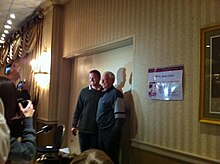Don Larsen's perfect game
Casey Stengel, the manager of the Yankees, selected Larsen to start Game 2 against the Dodgers' Don Newcombe.
He gave up only one hit, a single by Gil Hodges, but walked four batters, which led to four runs in the process, but none of them were earned because of an error by first baseman Joe Collins.
[6] Larsen needed just 97 pitches to complete the game, and only one Dodger batter (Pee Wee Reese in the first inning) was able to get a three-ball count.
The closest the Dodgers came to a hit was in the second inning, when Jackie Robinson hit a line drive off third baseman Andy Carey's glove, the ball caroming to shortstop Gil McDougald, who threw Robinson out by a step, and in the fifth, when Mickey Mantle ran down Gil Hodges' deep fly ball in left center, making a spectacular backhanded catch.
In the Dodgers' ninth, Larsen retired Carl Furillo on a flyout to Bauer, then Roy Campanella on a grounder to second baseman Billy Martin.
[8][9] Mitchell tried to check his swing on the final pitch, but home plate umpire Babe Pinelli, who would retire at the end of this World Series, called it a strike.
The first inning of the telecast is still considered lost and was not aired by the MLB Network or included in a subsequent DVD release of the game.
His film also includes footage of Mickey Mantle's catch in center field; Whitey Ford warming up in the bullpen in the 9th inning; Duke Snider making a tumbling catch; and Larsen's last pitch and bear hug from Yogi Berra, as the Yankees and stadium security guards come running out of the dugout before the crowd runs across the field.
The film was shown to Larsen, Berra, Tony Kubek, Frank Howard, Bucky Dent, Moose Skowron, and several other former Yankees at a dinner in Palm Beach Gardens, Florida in 2007.
"[10] The other color film of the perfect game is 16 mm and was shot by Professional Golfers' Association member Al Mengert, who played in the Masters Tournament with Sam Snead.
[15] When the World Series ended, Larsen did a round of endorsements and promotional work around the United States, but he stopped soon after because it was "disrupting his routine".
Because there had not been a perfect game since Charlie Robertson's in 1922, he thought he had simply accomplished an "extra good no-hitter" until someone in the clubhouse informed him afterward.
